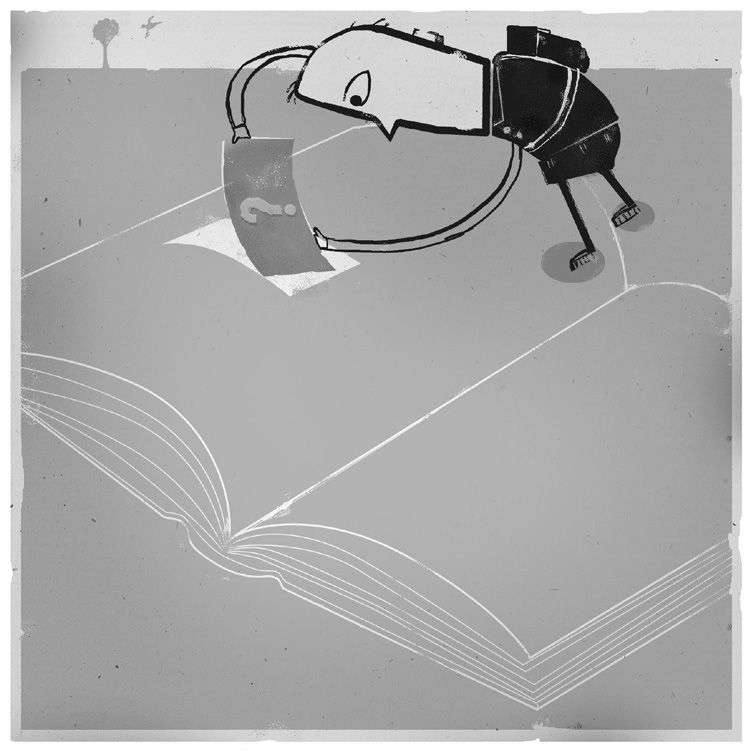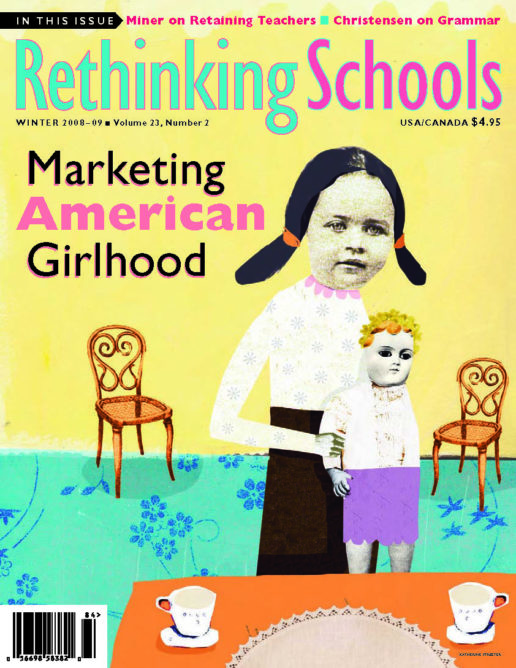10 Quick Ways to Analyze Children’s Books for Ableism
Prejudice by able-bodied and able-minded people toward people with disabilities
Illustrator: Brucie Rosch

Literature helps children understand themselves, their peers, their communities, their histories, and their world; the messages within can last a lifetime. In Rethinking Our Classrooms: Teaching for Equity and Justice, the Council on Interracial Books for Children (CIBC) warned that books can also expose young people to powerful racist and sexist attitudes that “gradually distort their perceptions until stereotypes and myths about minorities and women are accepted as reality.” Young people are also exposed to “ableism,” Thomas Hehir’s term — prejudice by able-bodied and able-minded people — that distorts perceptions of people with disabilities and helps maintain biases and myths about disabilities.
Although an estimated 20 percent of people in the U.S. have one or more type of disability, there are disproportionately few children’s picture books about people with, or addressing the issue of disability. According to Nina Christensen the limited number of books depicting disability increases the power of the few that are available: the dearth creates a tendency to uncritically promote any books with messages about disability. If we believe the role of schools is to confront societal biases, teach for equity and justice, and create hopeful glimpses of the kind of society we would like, we need not only to equip our classrooms with children’s literature that depicts disability, but also to find books that are of high aesthetic quality and accurately illuminate disability experiences. The stakes are high, because the way characters with disabilities are portrayed — what is said (and pictured) as well as what is not said (or pictured) — forms a hidden curriculum that has a powerful impact on how young people perceive disability. In “10 Quick Ways to Analyze Children’s Books for Racism and Sexism,” the CIBC advocated showing children how to detect racism and sexism, and provided 10 guidelines for critically evaluating children’s literature. We have adapted these guidelines, incorporating criteria from The Schneider Family Book Award that honors authors or illustrators for books embodying artistic expression of the disability experience.
1. Does the book promote ableism by ignoring people with disabilities?
Teachers have started to recognize problems with books that omit the stories of people of color, women, etc. So too, they need to be sensitive to the omission of persons with disability. This exclusion lessens the likelihood that the histories, experiences or feelings of people with disabilities will be discussed in our classrooms. Even negative portrayals of disability can present teachable moments.
2. Do the illustrations promote ableism by addressing disability in stereotyped ways?
- Notice hidden messages in images. Many picture books that portray disability are semi-nonfiction and use photographs intended to inform readers without disabilities. Use of photographs may contribute to the reader’s perception of reality. Picture books using photographs, therefore, deserve an especially comprehensive review because they are more likely to be seen as incontrovertible truth. Photographs also may deal with disability in a more clinical rather than aesthetic way, creating distance rather than empathy with a character with disability. Use of artistic illustrations, on the other hand, may result in an aesthetically satisfying story open to questioning.
- Analyze images for stereotypes associated with disability. For example, are characters with disability depicted as helpless or are they infantilized? Do the visuals illustrate people with disabilities in all their complexity or do they support demeaning clichés? For example, does a person with mental disability always have to look happy? The use of images in children’s literature may also encourage presentation of so-called “visible” disabilities, and avoid more “invisible” disabilities.
- Review the roles of characters with disabilities in the visuals. Are they presented in leadership roles and other times allowed to simply be there, or do they have to be a character or a literary device to convey a message?
3. Does the story line promote ableism?
- Evaluate the standard for success for characters with disabilities. Do they have to exhibit extraordinary qualities or superhuman powers in order to gain acceptance and approval? For example, does a protagonist who cannot walk have to solve a mystery from his/her wheelchair to avoid being bullied?
- Consider the presentation and resolution of problems in the story. Is the person with a disability “the problem?” Will the problems presented in the text encourage discussion and exploration of values or are they overly preachy? Do we learn anything about specific problems that people with disabilities regularly encounter? Are these oppressions — for example, constant ridicule, ostracism, being feared, and having no independence — related to an unjust and ableist society? Are problems faced by a person with a disability only resolved through the benevolent intervention of a person without disabilities? Are the problems considered inevitable or do they encourage questioning, active resistance, or even a shift in thinking about disability?
- Assess the credibility and three-dimensionality of characters with disabilities. Is their emotional, mental, or physical disability portrayed as part of a full life, rather than something that is all-consuming, to be pitied, or overcome? Are people with disabilities only present as literary devices to convey conflicting classic binaries: power or impotence, favor or rejection, good or evil, inner struggle or enlightenment, suffering or cure? For example, does a protagonist have to become blind in order to “see?”
4. Do loaded words convey negative messages about disability?
- Look for adjectives that diminish and restrict our view of people with disabilities. Examples of unfavorable adjectives include “wheelchair-bound,” “confined to a wheelchair,” “suffers from… ,” “lame,” “poor,” “little,” “victim,” and “crippled,” since they reinforce impotence.
- Review figurative language for unconscious negative values and beliefs about disability. The following are examples of figurative language with insulting overtones: “deaf as a post,” “blind as a bat,” “blind drunk,” “blind leading the blind,” “lame duck,” “lame joke,” “dumb blond,” “dumbstruck,” “dumbfounded,” and “idiot proof.”
- Watch for descriptions of disability that overshadow the person. Is the disability the first thing we hear about the person, or does the author use “People First” language? The following examples show how ableist language can be avoided: “a girl with Down Syndrome” instead of “a Downs baby”; “a man with a disability” instead of “a disabled person”; “a child receiving special educational services” instead of “a special ed kid.” In each of these pairs, the latter formulation puts the emphasis on the difference, and the former stresses the commonality.
5. Are characters with disabilities portrayed as three-dimensional people who belong or as flat, stereotyped outsiders?
Do we see the people beyond their disability? Are people with disabilities depicted as having lifestyles, cultures, and personalities? Do we learn anything about daily living challenges (difficulties associated with poverty, self-determination, transportation, education, housing, caregivers) regularly encountered by people with disabilities or their problems (loneliness, ridicule, excessive attention) experienced as a result of lack of societal acceptance? Do the text and images oversimplify these challenges and reinforce categories of normal “us” and different “them?” Is disability seen as synonymous with being disenfranchised, poor, ostracized, or marginalized?
6. Who in the story has agency? Are people with disabilities always the recipients of the efforts of others or are they portrayed with value?
Do the able-bodied characters make the important decisions and assume all of the leadership? Are people with disabilities typically in a supporting role? This disparity is often heightened by portraying adults with disabilities as less competent than children without disabilities. Do characters with disabilities have socially valued roles, such as physician, teacher, or lawyer, or only dependent roles, such as patient, student, and defendant?
7. Are characters with disabilities ever in the role of hero, or are they always victims to be rescued by the hero?
Many children’s books are built around a key hero, to whom the child can aspire. Heroes are different, but those differences are presented as positive. Can children without disabilities see a character with a disability as a hero — independent of their disability — and can children with a disability see a hero who looks like them?
8. Does the book promote positive self-image for people with disabilities?
A child can form a positive self-image by seeing characters who look like them represented in significant ways in the literature they read. That identification supports interest, reading comprehension, and contributes to self-concept. What if children never see characters who look like them? What happens when the few times a character appears who looks like them, the child learns this character is dependent, evil, weak, or tangential to the story? How can a child develop a strong self-concept if characters with disabilities are absent or are not valued? What is the hidden curriculum?
9. Is there something in the author’s and illustrator’s backgrounds that recommends them to writing about the disability experience accurately and with sensitivity?
Look at the jacket flap, the back of the book, and the foreword for biographical information. If the book discusses disability or has representations of disability, what qualifies the author to discuss the subject? Does the author or the illustrator have a disability, or do they have family members with disabilities? The majority of U.S. children’s books continue to be written by white, able-bodied, middle class authors, resulting in the predominance of an illusory, single perspective.
10. Look at the copyright dates
The Civil Rights Movement brought a wave of children’s literature dealing with minority themes, and many more books depicting disability were published after the mid-1960s. “Disability” became a more viable theme amidst the deluge of “problem” stories produced in this era that discussed hitherto taboo ideas: family fragmentation, social dislocation, personal trauma, educational inequity, and societal oppression. In early portrayals of disability, it was common to find a “cure” or “miracle cure” for the affliction, but by the 1970s, the trend was toward the realistic. Simultaneously, advocacy groups, according to Barbara Baskin and Karen Harris, became skillful in raising awareness about disability and publications started to depict a greater range of disability with more complexity and ambiguity. Orthopedic or visual impairments remain the most commonly presented disabilities in children’s literature, but the American Library Association has produced a limited list of outstanding books (with copyright dates of 1998 and beyond) that portray various kinds of disability experiences including agoraphobia, Alzheimer’s syndrome, autism, cerebral palsy, Down syndrome, dyslexia, and schizophrenia. Since 2003, the Schneider Family Book Award has recognized books addressing disability, written for readers across the P-12 age group.
An article in a recent issue of Rethinking Schools stated that “without social justice teaching inside classrooms, even much needed reforms in funding equity or school governance will have limited impact.” One piece of the social justice puzzle is to stock our bookshelves with non-ableist literature. Given the paucity of such literature, teachers, parents, and caregivers also need to think about their role in mediating reading experiences. We would never suggest banning books but we do call upon adults to provide a critical lens through which children can process bias. We propose seizing the teachable moment and asking the young reader important questions. For example, “What if the prince stayed blind? Could he still marry Repunzel?” or “Did you know that President Roosevelt had a disability that was not mentioned in the book?”
References
Baskin, B. & Harris, K. (1977). Notes from a Different Drummer: A Guide to Juvenile Fiction Portraying the Handicapped. New York: R.R. Bowler Company.
Christensen, N. (2001). What’s the Difference? The Depiction of Down Syndrome in Picture Books. Bookbird, 39(1), 17-22.
CIBC (2007). 10 quick Ways to Analyze Children’s Books for Racism and Sexism. Rethinking Our Classrooms: Teaching for Equity and Justice. Rethinking Schools, Ltd.
Hehir, T. (2002). Eliminating Ableism in Education. Harvard Educational Review, 72(1), 1-32 Spring.
Schneider Family Book Award Criteria: https://www.ala.org/awardsgrants/awards/1/apply

